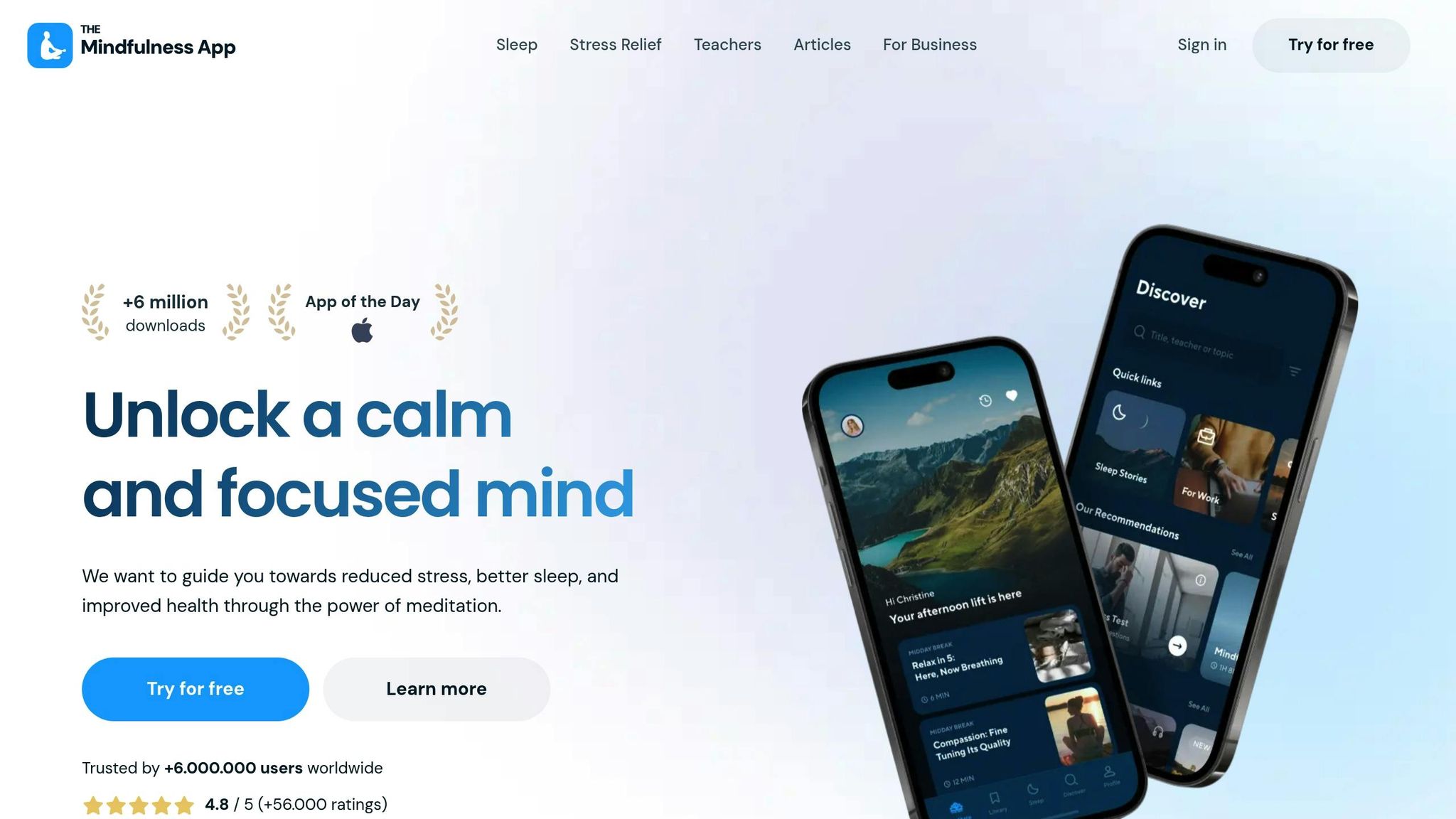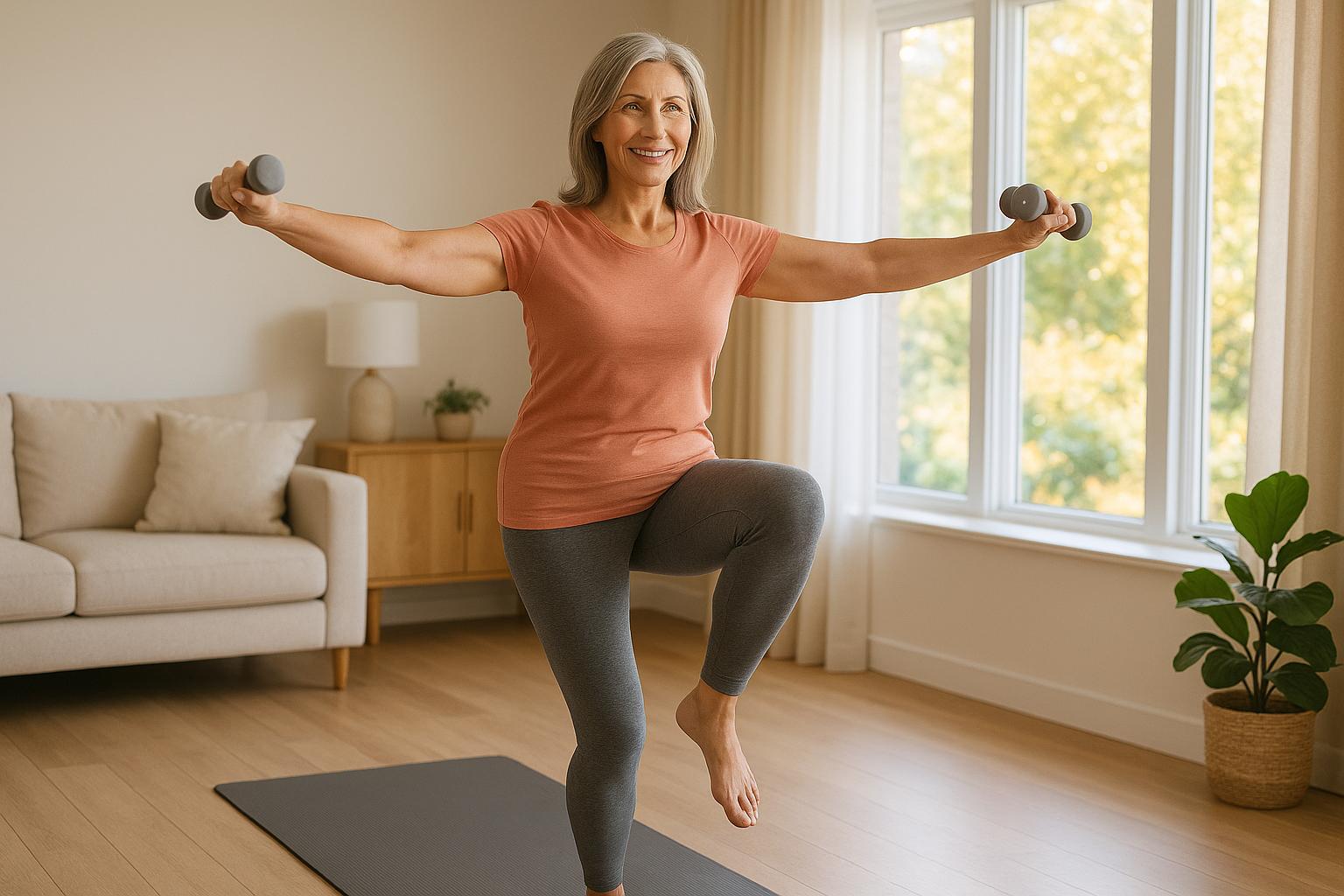Want to stay active and independent after 50? Focus on two key areas: bone strength and balance. Hormonal changes post-menopause can lead to bone loss and stability issues, increasing the risk of falls and fractures. A combined approach of weight-bearing exercises, resistance training, and balance drills can help you maintain mobility and reduce fall risks.
Key Takeaways:
- Bone Health: Incorporate walking, stair climbing, resistance training, and controlled-impact exercises like heel drops or step-ups.
- Balance Training: Start with single-leg stands, heel-to-toe walking, or chair-supported squats. Progress to yoga, tai chi, or tools like balance boards for added challenge.
- Consistency Matters: Aim for 2–3 sessions per week and track progress with tools like HealthView or The Do App.
- Professional Guidance: Consult a trainer or doctor if you have specific concerns, and ensure proper calcium and vitamin D intake.
This structured routine not only strengthens your body but also boosts confidence in daily activities like climbing stairs or playing with grandkids. Ready to build a stronger, steadier you?
Exercise for Osteoporosis, Osteopenia & Strong Bones
Bone Density Training: Strengthening Bones for Longevity
Maintaining strong bones is key to staying active and independent, especially after menopause when bone loss tends to accelerate. Incorporating specific exercises into your routine can help preserve bone strength and stability, supporting long-term health.
Weight-Bearing Exercises for Bone Health
Weight-bearing exercises are a great starting point, as they encourage your bones to stay strong by working against gravity. Start with low-impact movements and gradually increase intensity.
- Walking: Brisk walking for 20–30 minutes, three times a week, is an excellent choice. Add inclines or uneven terrain to increase the challenge.
- Stair Climbing: Climbing stairs or using a step platform targets your hips, legs, and spine. Begin with 5–10 minutes and extend the duration as you build strength.
- Dancing: Activities like ballroom or line dancing combine weight-bearing movement with balance and coordination, making workouts both effective and enjoyable.
- Low-Impact Aerobics: These structured routines challenge your bones while being gentle on your joints. Look for classes tailored to women over 50 or those offering modifications.
Pair these exercises with resistance training to create a well-rounded approach to bone health.
Resistance Training for Strength
Resistance exercises are essential for building muscle strength, which helps protect and support your bones. Incorporate these into your routine for added benefits:
- Free Weights: Start with 3–5 lb dumbbells for upper body exercises and bodyweight squats or lunges for the lower body. Gradually increase weight or repetitions as you improve.
- Resistance Bands: These are gentle on joints and provide adjustable resistance. Focus on strengthening areas like the spine, hips, and wrists.
- Bodyweight Exercises: Moves like squats (use a chair for support if needed) and wall push-ups are adaptable to all fitness levels and require no equipment.
- Modified Planks: Begin with wall planks, then progress to incline planks using a sturdy surface to build core strength for spinal support.
Aim for resistance training twice a week with at least one rest day in between. Perform 8–12 repetitions of each exercise, using enough resistance to feel challenged by the final rep.
Safe Jump Training for Bone Health
Controlled-impact exercises like jump training can further boost bone density, but it’s important to approach these with care, especially if you have balance or joint concerns.
- Heel Drops: Stand on your toes, then lower your heels with control to create a mild impact through your spine and hips. Start with 10–15 repetitions daily.
- Step-Ups with Controlled Landings: Step onto a 6–8 inch platform, then lower yourself slowly to focus on soft, deliberate landings.
- Modified Jumping Jacks: Keep one foot grounded at all times to reduce impact, progressing to small jumps as your comfort level grows.
- Vertical Mini-Jumps: Begin with light hops, just barely lifting off the ground, and focus on landing softly with bent knees.
If you’re new to jump training, start with 2–3 exercises, performed 2–3 times a week on non-consecutive days. Use safe surfaces like wooden floors or exercise mats, wear supportive shoes, and stop immediately if you feel joint pain.
Balance Work: Improving Stability and Preventing Falls
As we get older, falls become a bigger concern, particularly for older women. Incorporating balance training into your routine can lower the risk of falls and boost mobility. The good news? You don’t need fancy equipment - many effective exercises can be done right at home. While bone-strengthening exercises lay the groundwork, balance training directly tackles the issue of stability.
Simple Balance Exercises for Beginners
Starting with basic movements can help improve your stability while keeping things safe. These exercises retrain your body’s natural balance responses and strengthen the smaller muscles that keep you steady.
- Single-leg stands: Stand behind a sturdy chair, lift one foot off the ground, and hold the position for 10–15 seconds. As you get better, try it without holding onto the chair or even with your eyes closed. Work up to holding the pose for 30 seconds on each leg.
- Heel-to-toe walking: Walk in a straight line by placing one foot directly in front of the other, with the heel touching the toe. Aim for 10–20 steps. With regular practice, you’ll likely notice your coordination improving.
- Chair-supported squats: Stand facing a chair, lower yourself until you just touch the seat, and then rise back up. Start with 5–10 controlled repetitions, increasing as your strength builds.
- Standing marches: Hold onto a countertop for support, lift one knee toward your chest, hold for 2–3 seconds, and then switch legs. Try 10–15 repetitions on each side.
Yoga and Tai Chi for Stability and Mindfulness
Yoga and tai chi are fantastic for combining balance training with relaxation. Their gentle, flowing movements not only improve stability but also help reduce stress.
- Tree pose: Shift your weight onto one foot and place the other foot on your inner leg (avoiding the knee). Hold for 15–30 seconds before switching sides. Use a wall for support if needed.
- Warrior III: From a standing position, hinge forward at your hips while lifting one leg behind you. Aim to create a straight line from your fingertips to your toes. Hold for 10–15 seconds, gradually working up to 30 seconds.
Tai chi focuses on slow, deliberate weight shifting. Start with simple side-to-side shifts, lifting one foot slightly as you transfer your weight. As you progress, try forward and backward shifts. These movements improve stability in everyday activities.
A popular tai chi movement, the single whip, blends balance, coordination, and gentle strength. Beginners can focus on the weight-shifting aspect, transferring weight from one leg to the other while staying aware of their center of gravity.
These mindful practices work well alongside strength training, preparing you for more advanced balance challenges.
Using Tools to Improve Balance Training
If you’re ready to take your balance training up a notch, specialized tools can add variety and increase the challenge. Always prioritize safety when trying new equipment.
- Balance boards or wobble cushions: These create an unstable surface, forcing your stabilizing muscles to work harder. Start by standing on the board while holding onto a sturdy surface like a wall. As you gain confidence, try short periods without support or add simple movements like arm raises. Keep sessions brief at first - 5–10 minutes is plenty.
- Stability balls: Sitting on a stability ball activates your core muscles and improves posture. Once you’re comfortable, try gentle bouncing or lifting one foot off the ground at a time. Make sure the ball is the right size - your knees should be at a 90-degree angle with your feet flat on the floor.
- Resistance bands: Using resistance bands can add a little extra challenge to your balance exercises. For example, stand on one end of the band, hold the other end, and perform simple arm movements. This approach combines strength and balance in a controlled way.
Whenever you use balance tools, make sure you have a spotter or stable support nearby, especially when trying something new. Exercise on non-slip surfaces, wear supportive shoes, and keep your workout area well-lit and free of clutter to avoid accidents.
sbb-itb-72d195f
Using Growth Bundle Apps for Bone and Balance Goals

Incorporating digital tools into your fitness journey can make a big difference, especially when it comes to tracking progress and sticking to healthy habits. Growth Bundle apps are designed to complement your bone density and balance training, helping you stay on track and build consistency.
Tracking Progress with HealthView

HealthView transforms your iPhone into a personalized health dashboard by integrating with Apple Health. It organizes your fitness data into an easy-to-read format, making it simple to monitor your progress. If you're focusing on bone density, HealthView tracks key metrics like Steps Count, Distance, Workouts, Exercise, Weight, BMI, Body Fat, Lean Body Mass, and even Calcium and Vitamin D intake. Its monthly trend views are particularly helpful, allowing you to spot patterns and understand your progress over time rather than getting caught up in daily changes.
The app also works seamlessly with Apple Watch and offers customizable home screen widgets for quick updates. With a stellar rating of 4.6 out of 5 across more than 190,000 reviews in the Growth Bundle ecosystem, HealthView has earned the trust of many users. Plus, it prioritizes your privacy by only reading data from Apple Health, ensuring your information stays secure.
Building Consistency with The Do App
Staying consistent is key when it comes to improving bone density and balance, and that's where The Do App shines. This app is all about helping you stick to your habits. By tracking routines and trends, The Do App keeps you motivated and organized, even during busy times. Its straightforward design makes it easy to maintain a regular exercise schedule without overcomplicating things.
Mindfulness and Recovery with The Mindfulness App

Recovery and stress management are just as important as physical training. The Mindfulness App offers guided meditations that improve body awareness - an essential skill for balance training. Regular mindfulness practice can reduce stress, enhance sleep, and aid recovery. Its flexible format works with any schedule, making it a practical addition to your routine.
Many users find that combining mindfulness with physical training creates a well-rounded approach to aging gracefully. These apps integrate effortlessly into your overall fitness strategy, reinforcing the lessons from earlier sections and helping you achieve your goals.
Building a Long-Term Bone and Balance Practice
Strengthening your bones and improving balance isn’t just about short-term gains - it’s about creating habits that support your independence and well-being for years to come. By combining consistent effort, clear goals, and professional guidance, you can lay the groundwork for a healthier, more active future.
Key Takeaways for Women Over 50
Here’s what you need to remember: regular weight-bearing, resistance, and balance exercises add up over time. Each session builds on the last, helping you feel stronger and more confident in your daily life. Whether it’s climbing stairs, carrying groceries, or playing with your grandkids, these small steps lead to big improvements.
Practical Tips for Staying Motivated
Sticking with a routine can be tough, but these tips can help you stay on track:
- Start small. Kick things off with two to three sessions a week, focusing on proper form. As you grow stronger, gradually increase the intensity and frequency.
- Celebrate progress beyond the scale. Improvements in balance, posture, and mobility can be just as rewarding as any changes in weight. Notice how everyday tasks become easier over time.
- Find accountability. Partner with a friend, join a class, or use tools like The Do App to stay consistent.
- Listen to your body. On low-energy days, opt for gentler activities like yoga or tai chi. On others, challenge yourself with resistance exercises. Mixing it up keeps things interesting and sustainable.
Consulting Professionals for Guidance
Professional advice can make all the difference in tailoring your exercise routine to your needs. If you’re dealing with issues like pain, frequent falls, or other concerns, reach out to your doctor or a physiotherapist for personalized recommendations.
Qualified fitness professionals, particularly those experienced in osteoporosis and balance training, can design a program that’s both safe and effective. If you’re exploring resistance training, consider working with a personal trainer who can guide you through proper techniques and equipment use. Pay attention to your body - if something feels off, like back strain, stop and adjust your approach.
For nutritional support, consult a registered dietitian about calcium and vitamin D intake. The Bone Health & Osteoporosis Foundation is another great resource for finding experts in your area and staying updated on the latest bone health research.
FAQs
Why is combining bone density training with balance exercises important for women over 50?
Combining bone-strengthening exercises with balance-focused activities is incredibly important for women over 50. These practices work together to boost bone health, improve stability, and support overall well-being. Weight-bearing and resistance exercises are particularly effective at increasing bone density in areas like the spine and hips - regions that become more vulnerable to fractures with age.
Adding balance exercises, such as yoga or tai chi, can further enhance stability and lower the risk of falls, which are a major cause of injuries in older adults. By integrating these two types of exercises, women can not only protect their bones but also maintain their independence and reduce the chances of developing osteoporosis.
What’s the safest way to start jump training if I have joint issues?
If you have concerns about your joints, it’s smart to start jump training with low-impact adjustments to reduce stress on them. Try using soft surfaces like a cushioned mat or a low step, and focus on controlled movements. Keep a slight bend in your knees to help absorb the impact - this can ease strain while still helping you build strength and improve stability.
Before diving in, it’s a good idea to consult a healthcare provider or a certified fitness professional to make sure the exercises are suitable for your needs. Start slowly, and only increase intensity as your body gets used to the movements. Pay close attention to how your joints feel during the workout, and always prioritize maintaining proper form to avoid injuries.
How can digital tools like HealthView and The Do App help women over 50 stay consistent and track progress in bone and balance training?
Digital tools such as HealthView and The Do App are great for helping women over 50 maintain consistency with bone density and balance exercises. These apps come with handy features like progress tracking, personalized reminders, and visual charts that let users monitor their improvements over time.
By highlighting changes in bone strength and balance, these tools keep users motivated and provide useful feedback for tweaking their routines when necessary. The regular tracking and timely reminders encourage the development of steady exercise habits, promoting better long-term health while lowering the chances of falls, fractures, and osteoporosis.
